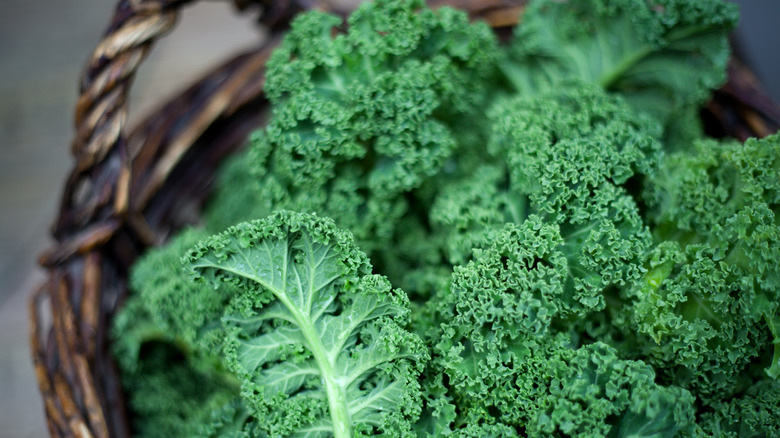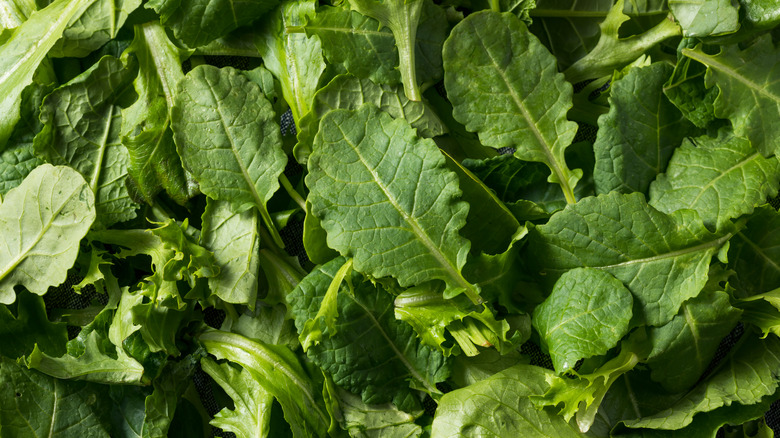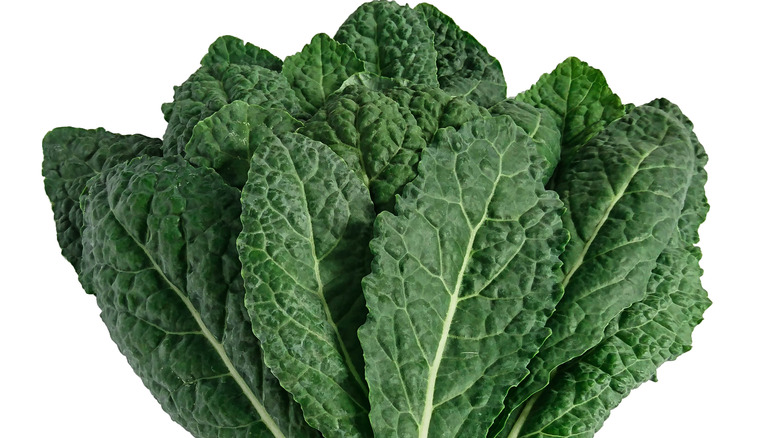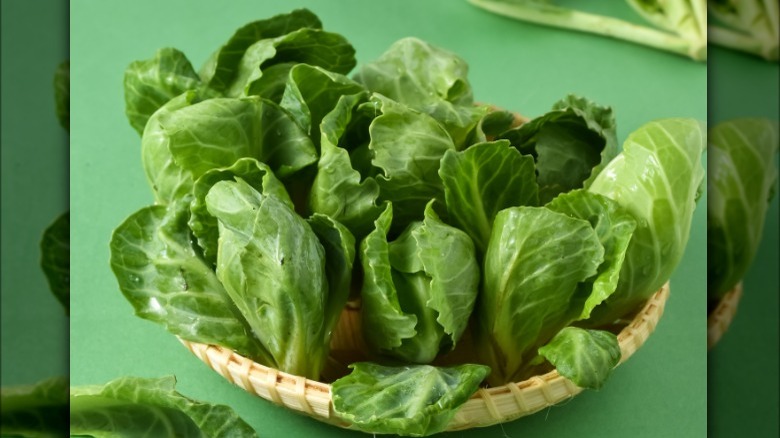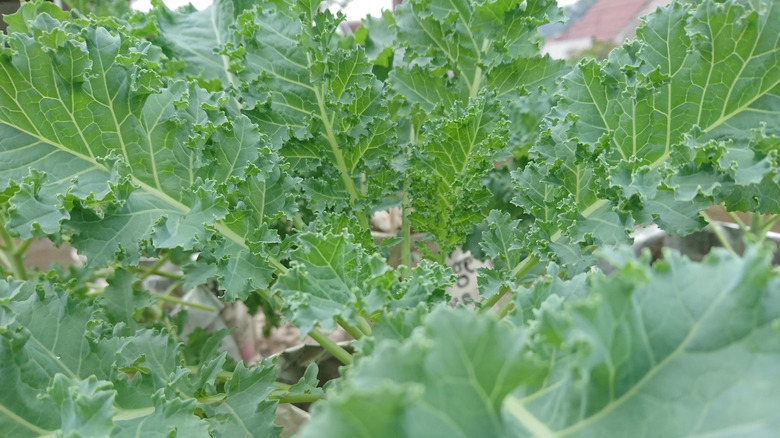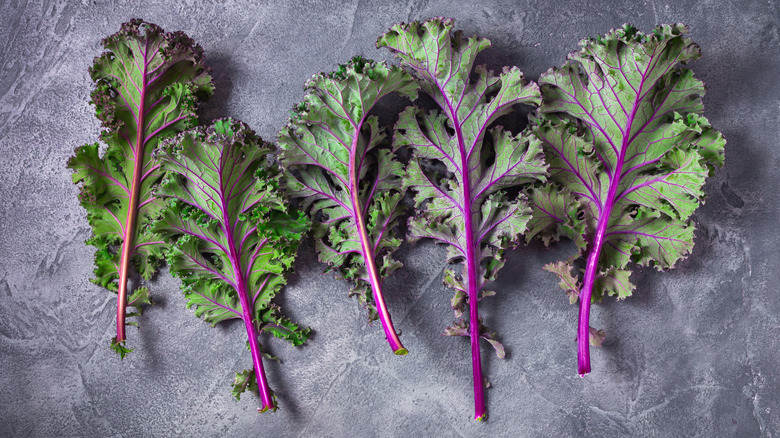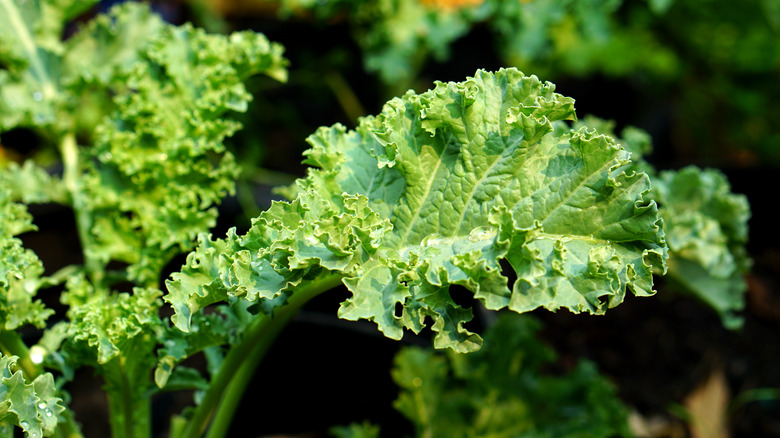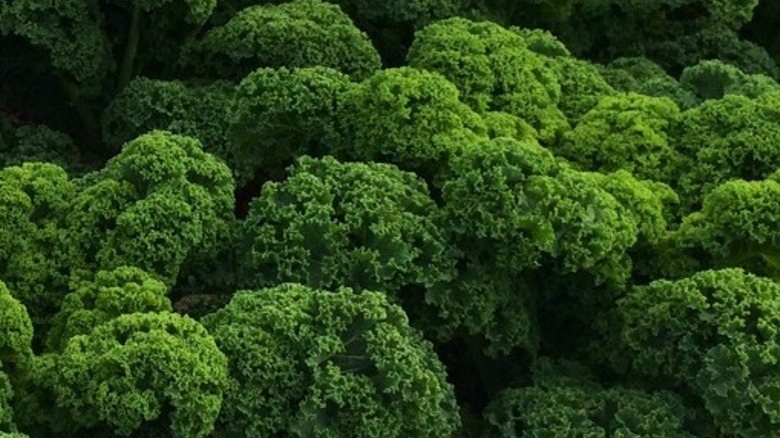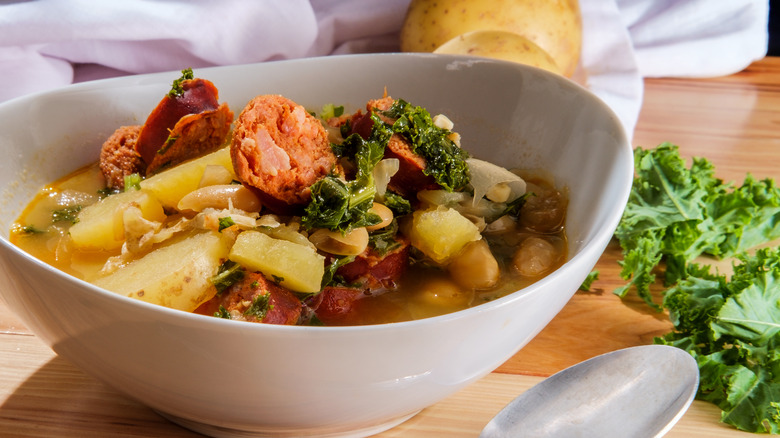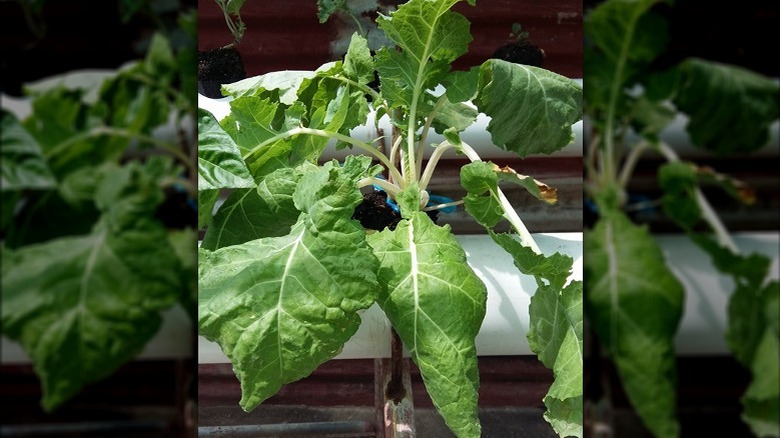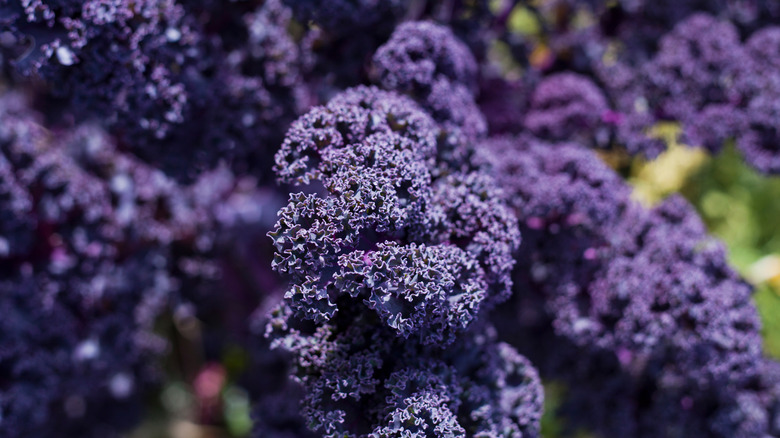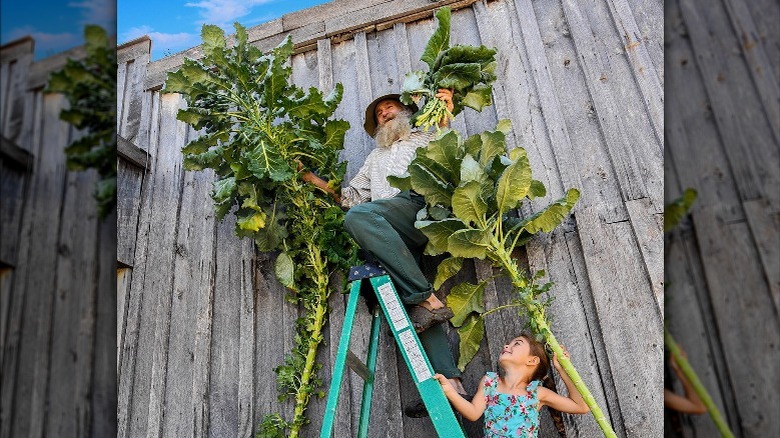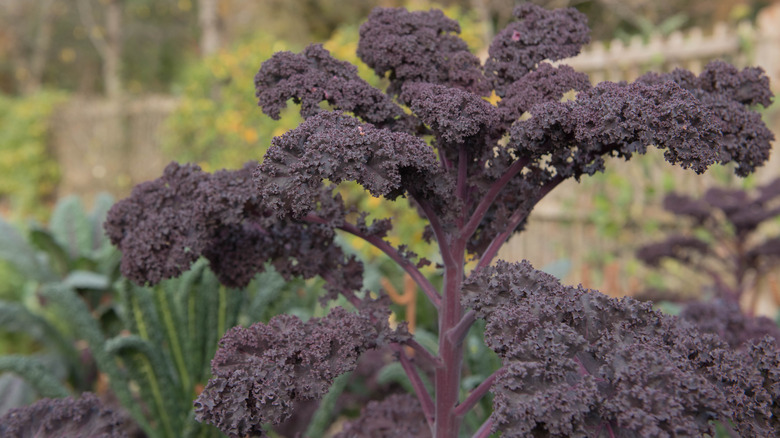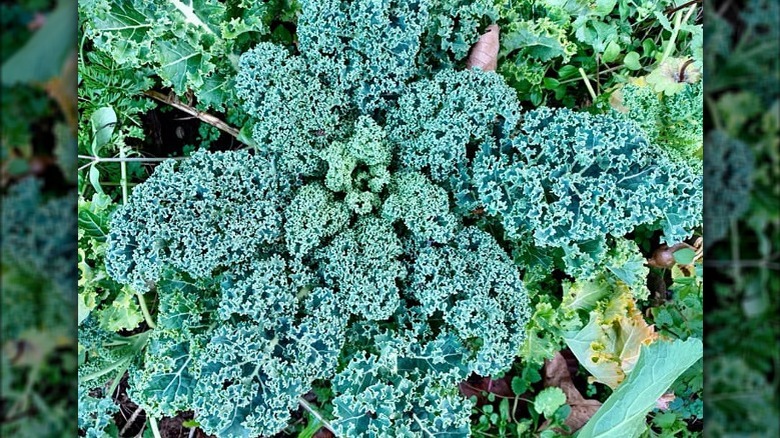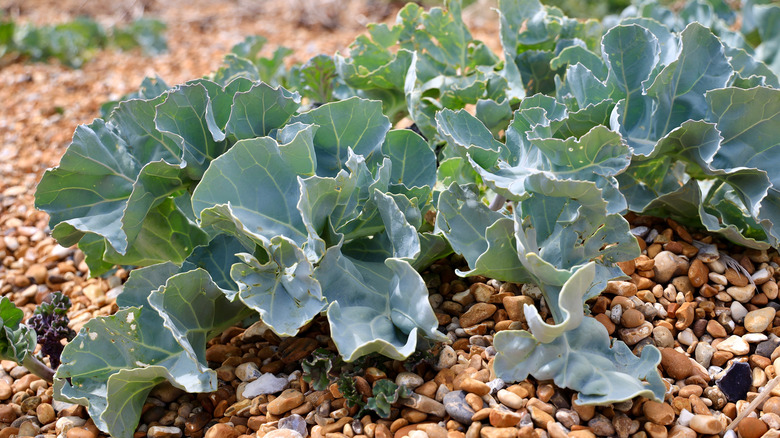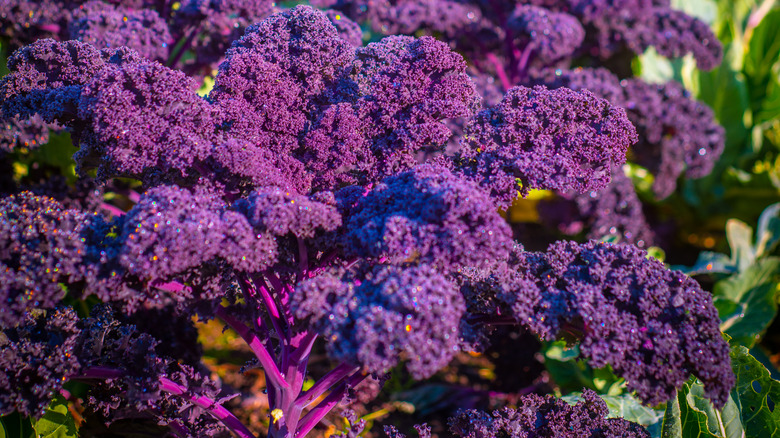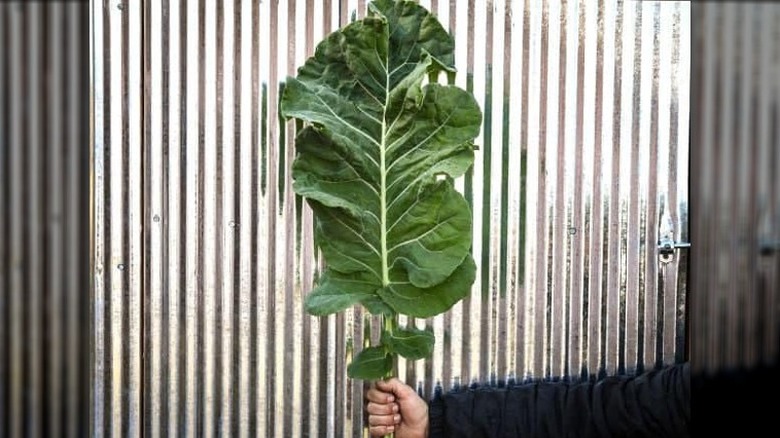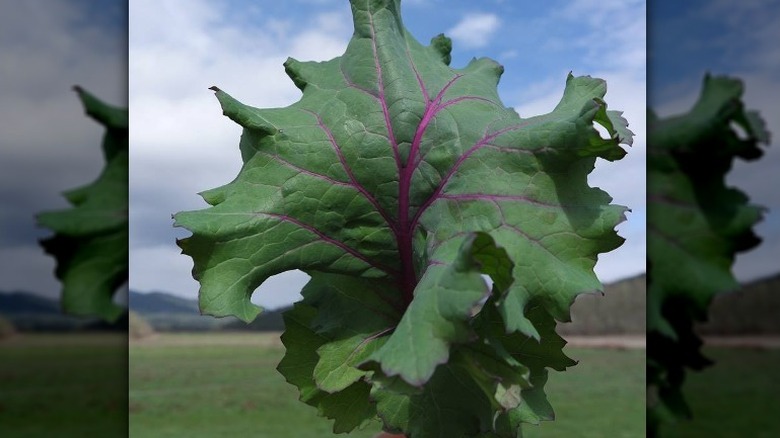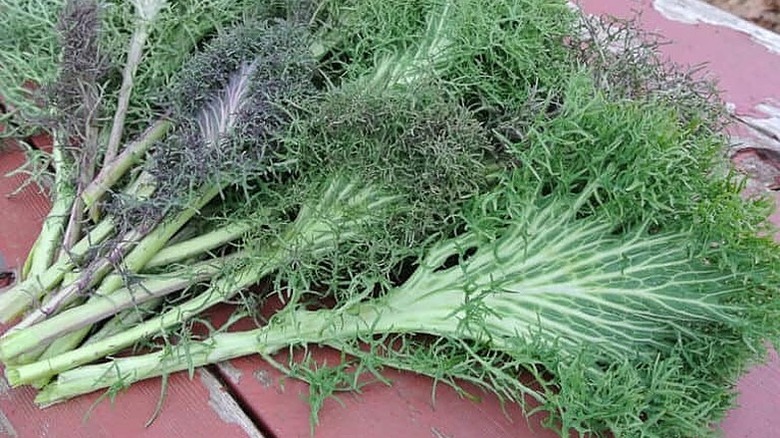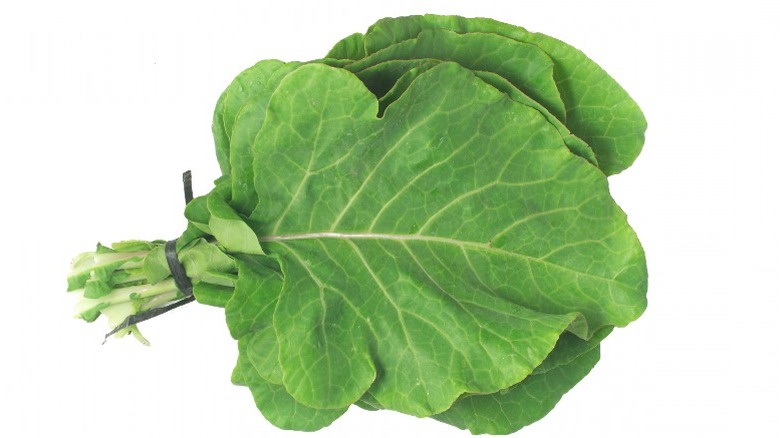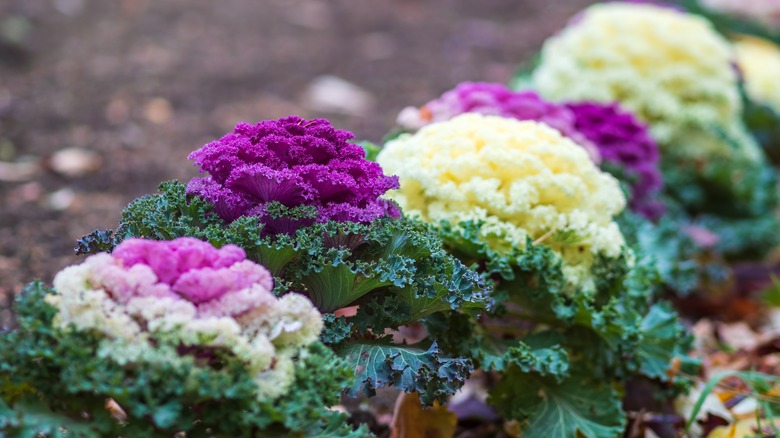20 Types Of Kale And What Makes Them Unique
Kale can be a contentious vegetable. People seem to either love it or hate it. And while it may feel like a diet fad, this headless cabbage has actually been around for a long time. The third president of the United States, Thomas Jefferson himself, grew different varieties of kale at his plantation home in Virginia. Before that, kale was popular in Europe, Asia, and among the ancient Romans and Greeks.
Part of kale's popularity can be attributed to how healthy it is for us. Not only is kale low in calories and packed with essential vitamins and nutrients, but eating it is good for our mental and emotional health as well. As psychiatrist Drew Ramsey tells The New York Times, "The nutrients in kale help to make us feel optimistic and ward off depression."
If you think you don't like kale, you should reconsider. After all, there are over 20 varieties out there and several different ways of enjoying them. It can be eaten raw, sauteed, steamed, stewed, turned into chips, and incorporated into foods like smoothies, burger patties, and bread. Give kale another look. It might surprise you.
1. Baby kale
Baby kale isn't its own variety but rather a young kale plant that has yet to mature, harvested around 30 days instead of 60. That means it can consist of any type of kale. This is a great way to enjoy the raw vegetable because the leaves and stems are more tender than if fully mature, yet hardier than other greens. Kale easily withstands cooler temperatures, becoming even sweeter after a frost.
People have described the taste of baby kale as peppery, nutty, and earthy. This will depend on the variety and how it is being served. Use it in the same ways as you would arugula and toss it in with other greens for a mixed salad, blend it into a smoothie, saute it alone or with vegetables, blend it into a pesto, or use it as a pizza topping. There's no need to massage it — the leaves are tender enough as is.
2. Tuscan kale
As an easy to grow variety, Tuscan kale has many names. You may know it as lacinato, palm tree, black palm, or dinosaur kale. Originating in Italy, hence the name, it is one of the varieties that Thomas Jefferson grew at Monticello.
Tuscan kale leaves are long, narrow, crinkly, and dark in color. The ribbed texture of the leaves led to the name dinosaur kale, as some people thought it resembled reptile skin. If properly cared for, one plant can reach up to three feet in length, which is pretty impressive. Like other varieties, Tuscan kale can handle cooler temperatures, but it can also weather heat better than its fellow counterparts.
This type of kale can be frozen but it should be blanched first for optimal results. Leaves can also be fermented, dehydrated, or made into kale chips. This is also a good one to harvest early to use as baby kale. Or get in tune with its Italian roots and use it in a homemade minestrone soup.
3. Chinese kale
This fast-growing variety is also known as gai lan, kailaan, or sometimes Chinese broccoli. Both kale and broccoli are cultivars of the same plant species, Brassica oleracea. Meanwhile, broccolini (aka baby broccoli) is a hybrid of broccoli and Chinese kale. Native to China, this variety of kale is often found in stir-fried dishes and soups or boiled whole and served with a sauce. All parts of the plant are edible, including the flower. This is another one that can be harvested early as baby kale.
While it physically resembles spinach more than it does other types of kale on this list, its flavor falls somewhere between kale and broccoli. The flowers have a similar taste to the leaves and stem and are less bitter if the bud hasn't yet opened. You can also use the flowers as an attractive garnish. If you can't find Chinese kale at your usual local grocery, try an Asian market with a wider selection.
4. Siberian kale
Siberian kale really sets itself apart from others on this list. For starters, it's a cultivar of Brassica napus, not Brassica oleracea, which means it is more closely related to rutabaga than to Tuscan kale. That being said, it is not used as a root vegetable in the kitchen. Much like with other types of kale, we eat the leaves.
The flavor and texture of Siberian kale also differ from other varieties. The leaves are more tender and have a milder, less bitter flavor, which makes them ideal for consuming raw in a salad. Still, they can also be used in sautes, soups, and other cooked dishes. Depending on the use, leaves can be harvested fully mature or early as baby kale.
Siberian kale is low-maintenance and easy to grow. It is also more cold- and insect-resistant than others, making it a wonderful addition to anyone's vegetable garden. Not to mention, its golden flowers attract pollinators so the entire ecosystem can benefit from its presence.
5. Red Russian kale
Like Siberian kale, Red Russian kale is a cultivar of Brassica napus. Its name comes from its red stalk, which is thick but tender, though the leaves are green. Its physical attributes make it an ornamental garden plant in addition to being edible.
Red Russian kale is considered by many to be the sweetest and mildest variety. Not only is it packed with the same nutritional boost as the green stuff, but its red pigmentation comes from anthocyanins. According to a 2017 research published in Food & Nutrition Research, these compounds have numerous health benefits including antioxidants and antimicrobials. Among their many qualities, they assist in maintaining healthy eyes and nervous systems. You'll want to add Red Russian kale to smoothies and salads or enjoy it on its own either steamed or stir-fried.
If you're growing it, this plant loves the sun but doesn't do well in the heat, so the best times to plant it are spring and fall. If you want your greens fast, harvest baby leaves in as early as 25 days.
6. Curly kale
Curly kale may be the most recognizable type to most people. As the name implies, the leaves are almost lace-like in their extreme curliness. Though it is often used to garnish plates, it is also fully edible. Still, the attractive leaves make this variety popular for garden pots and boxes.
An easy way to cook curly kale is to remove the tough stems and then chop and boil the leaves. They can also be steamed, stir-fried, or used as a substitute for cabbage or spinach in many recipes. Or, simply coat them in oil and crisp them up in the oven or air-fryer.
When growing your own plant, start in the springtime if you intend to harvest the leaves young. If you prefer a mature plant, plant it in the fall when you don't need to worry about the hot summer sun harming it. Harvest what you need, leaving the smaller leaves to continue maturing for a future harvest.
7. Prizm kale
If you like curly kale, then you have to try prizm kale. Its bright green leaves are so tightly curled that it has been compared to parsley. The plant is also smaller than other kale varieties, only growing up to about 15 inches in height and a dozen inches in width, making it perfect for container gardening either indoors or outdoors. The stalk is thin, and the plant regenerates its leaves soon after harvest, leading to multiple harvests per growing season.
Prizm kale is just as nutritious as its larger cousins. The leaves are tender, and the flavor is sweeter with an almost nutty taste that makes the raw leaves a great addition to salads. It is also tasty in soups, stews, smoothies, and any other way you'd use the leafy green, including as a garnish. Not to mention, some gardeners use it as an ornamental. This curly variety has received plenty of praise, and in 2016 it even won an All-America Selections Vegetable Award.
8. Portuguese kale
Portuguese kale, also known as Portuguese cabbage, is an heirloom variety that can grow up to two feet in height and three feet across. It takes longer to mature than other kale varieties, but the results are worth the wait. The dark green leaves are either large and paddle-shaped or curly. They are typically tender with a mild flavor but are even sweeter if harvested after a frost. On the flip side, if the plant is allowed to bloom the leaves become tough and bitter.
Beloved in its home country, Portuguese kale soup (also called Portuguese green soup, green soup, or caldo verde) is a simple and nutritious recipe that makes great use of the leaves. In some ways, this variety is similar to collard greens and can be used as a substitution in recipes. It can also be swapped with lettuce and cabbage depending on the preparation. For example, particularly broad leaves make terrific sandwich wraps.
9. Premier kale
Premier kale, also known as Early Hanover, is another compact variety that matures fairly quickly. It also does very well in containers, which makes it ideal for a patio garden. Its medium to dark green colored leaves are broad with very little curl around the edges. When fully mature, they are about the size of a human hand. Its nutritional content is impressive, with superior levels of antioxidants and beta carotene.
Safe whether eaten raw or cooked, the leaves can be used in wraps, green salads, smoothies, soups, and stews, and they also work as a substitution for collard greens, lettuce, and cabbage in recipes. Premier kale is a heavy producer, so if you find yourself with an abundance, simply store the leaves for five to seven days in the refrigerator or freeze them for future use. As with other kale plants, premier kale tastes sweeter after a frost and becomes bitter once it goes to seed.
10. Redbor kale
Are your salads too green for your taste? Looking for some pizzazz to change up the color of your smoothie? Look no further than purple Redbor kale leaves. Technically the leaf color can range from green to magenta to deep purple, which will liven up any dish you add it to. Keep in mind the color may fade a bit when cooked. Raw Redbor kale is a little on the bitter side but cooking makes it sweeter and more tender. This is a great option to add to soups, stews, or similar dishes.
Redbor kale is chock-full of vitamins A and C, iron, calcium, magnesium, potassium, protein, carbohydrates, as well as fiber. Just like Red Russian, Redbor contains anthocyanin pigments, which have powerful antioxidant properties. The pigments also make this variety a suitable natural food dye. Because it is so striking, some gardeners also use it as an ornamental plant, though the stalks and leaves are still fully edible.
11. Walking stick kale
Originating on the island of Jersey in the English Channel, walking stick kale is exactly what it sounds like: giant kale with a stalk that is so thick and tall it could be used as a walking stick. Traditionally, the leaves were used to feed the livestock that lived on the island, while the stalks were sold as walking sticks after being dried and varnished. Under the right conditions, walking stick kale can grow as tall as 20 feet. The leaves, which mostly cluster at the top of the plant, make the whole thing top-heavy at such a height, causing it to lean to the side.
If you want to grow your own walking stick kale, it is better to start from a cutting than from seeds. For optimal results, you will also want to stake it to keep it upright. If you don't own any livestock, you'll be glad to know the leaves make a terrific addition to soups, stews, and stir-fries, and can be used as wraps for sandwiches.
12. Scarlet kale
Scarlet kale is another variety with a color that really stands out. Its stems range from magenta to purple in color. The plant begins the season with lighter (sometimes green) curly leaves that darken as temperatures cool. By fall, the leaves should be a dark pink or purple, adding a lovely seasonal color to autumnal salads and other dishes. Baby leaves are best for eating raw, whereas mature leaves work well for cooking, juicing, or adding to smoothies. A single plant can be harvested multiple times in a season, and under the right circumstances, scarlet kale can grow up to five feet tall.
As you may have guessed by its color, scarlet kale contains anthocyanins, which have powerful antioxidant properties and support cardiovascular and neurological health. Not to mention, it's also full of vitamins, minerals, fiber, and an overall great addition to your diet. If you'd rather stick to gardening, the scarlet color is lovely as an ornamental plant, and it grows well in pots too.
13. Blue Curled Scotch kale
Blue Curled Scotch is a hardy variety that descended from a much older heirloom known as dwarf green curled kale. It was introduced to the produce market in 1950 by the Virginia Truck Experiment Station, which researched kale and the rest of its plant family in the early to mid-20th century.
Blue Curled Scotch has large blue-green leaves with curly edges, which make attractive albeit edible garnishes. And they are indeed worth eating. The leaves are tender and have a milder, less bitter, and almost nutty taste. Like other varieties of kale, this one tastes sweeter after a frost. Blue Curled Scotch is a great ingredient for making juices, smoothies, salads, and chips. Wider than they are tall, plants can be harvested in as little as 30 days and consumed as baby kale for an even more tender texture. Due to their compact size, Blue Curled Scotch kale plants are suitable for container gardening.
14. Sea kale
Sea kale is another variety that isn't technically kale in botanical terms. It is still part of the Brassicaceae family, but it belongs to the Crambe maritima species, not Brassica oleracea. It can grow in a large area of the country, seashore optional. The plant actually got its name from the days of lengthy sea travel, when it was pickled and eaten to prevent scurvy. Hence, one of its other names is scurvy grass, although anti-scurvy grass might be a better moniker. Thomas Jefferson also grew sea kale in his experimental gardening phase.
Both the leaves and the roots are edible. The former can be used in the same recipes as other types of kale and spinach, either raw or cooked. Similarly, the roots (which resemble asparagus) can be consumed both raw and cooked but should be blanched for long-term storage. Sea kale is a striking plant with flowers that easily attract pollinators. You'll have to stick to planting it in an outdoor garden though, as its long taproot and desire to spread out make it unsuitable for containers.
15. Purple kale
Per its name, purple kale is a vibrant purple color, with curly leaves that range from green to purple even on the same plant. To take full advantage of the color, you will want to eat it raw. As with the other darkly pigmented varieties on this list, the color will fade when cooked, becoming greener.
The flavor is stronger and more cabbage-like than its fellow varieties. The stems are tough so you will want to remove them and only consume the leaves. Green salads and smoothies are a good use of raw kale, and it works particularly well in Asian and Asian-inspired dishes, as well as for chips, soups, and stews.
The presence of anthocyanins makes this an even more nutritious variety than green ones, offering excellent support for cardiovascular, neurological, and visual health. Because it is so attractive, many gardeners grow it as an ornamental plant.
16. Thousandhead kale
Thousandhead kale is another large, hardy variety with broad, flat green leaves that can be as long as three feet. Meanwhile, the plant itself grows up to five feet tall and six feet wide. It is also pretty fast-growing, reaching maturity at between 50 and 65 days. Other names for Thousandhead kale include Thousand Headed, Hungry Gap, and Branching Borecole.
People in the U.K. have traditionally used this big variety to feed livestock, but it is also suitable for human consumption. The large size of the leaves makes them perfect to use for wraps. After being cut to a more usable size, they can also be added raw to salads and smoothies, steamed, sauteed, or cooked in soups or stews. With a leaf this big, you are only limited by your imagination. Nutritionally, Thousandhead kale is a great leafy green option that is high in vitamins A, C, and K as well as antioxidants and fiber.
17. Simone Broadleaf kale
Simone broadleaf is a variety that was only recently developed by Adaptive Seeds, a certified organic farm-based seed company located in Oregon, along with the Culinary Breeding Network founder Lane Selman and chef Tim Wastell.
The idea was to create a plant with properties that chefs would find useful. For example, the leaves are more easily stripped from the stems. The dark green leaves have purple ribs and wavy edges that are also quite attractive. The young leaves can already be harvested after only 25 days, and after 30 days the mature leaves can be harvested. Simone broadleaf is a Brassica napus species, which is milder and more tender, making it particularly tasty when served raw in green salads.
The name pays tribute to all Simones, including famous examples like the French existentialist philosopher Simone de Beauvoir and American performer Nina Simone, two important activists of the 20th century.
18. Bear Necessities kale
If you have ever thought that curly kale was all right but frilly kale would be better, allow us to introduce Bear Necessities, a recent creation by Oregon farmer Tim Peters. The colorful green and purple leaves are so frilled that they resemble certain types of seaweed, earning the plant the nickname the seaweed of kale.
The frilly leaf edges serve two purposes: First, they make them more tender; second, they seem to ward off a serious pest, the swede midge, which made its way to North America in the year 2000 from Europe or Southeast Asia. Swede midge larvae eat the tips of the leaves as they grow, leaving behind disfigured plants.
When used raw in a green salad, Bear Necessities add color and textural variety both visually and on the palate. Cofounder of Adaptive Seeds Sarah Kleeger told The New York Times, "It certainly gives a salad a lot of loft." There's no doubt that such an unusual-looking kale would be fun to chew.
19. Brazilian kale
Brazilian kale is a compact variety with broad, flat, green leaves. It can be eaten raw as well as used in cooking, though you will definitely want to remove the ribs. As one might expect, Brazilian kale is popular in Brazil and can be found all across the South American country.
Like the aforementioned Portuguese kale, Brazilian kale is sometimes used in caldo verde, aka green soup. It is also used to make feijoada completa, a traditional black bean stew from Rio De Janeiro. Yet another commonly served Brazilian dish that uses kale is couve a Mineira, which consists of the leafy green sauteed in butter with olive oil-roasted garlic. If you are interested in making Brazilian cuisine, this is the kale to use. When storing the leaves in the refrigerator, keep them whole to get a few more days out of them, as cut leaves spoil more quickly.
20. Ornamental kale
We have mentioned many pretty and colorful kale varieties in this list, however, here is a purely ornamental kind you will not want to eat. Although technically you can eat them without becoming ill, the stems and leaves are tougher and even more bitter than plants grown for culinary purposes, so leaving them for decoration is probably best.
Visually, kale adds color and interesting textures to a garden. Ornamental kales also look great mixed into bouquets, especially if you are going for a late summer or fall theme. Colors range from white to green to pink to purple and the leaves can be flat, curly, or frilly. One variety called Coral Prince has frilly leaves with a pink center. Meanwhile, Color Up has flatter leaves with white or magenta centers. Because kale leaves deepen in color as temperatures dip, planting these will keep your garden colorful when other flowers are past their prime.
